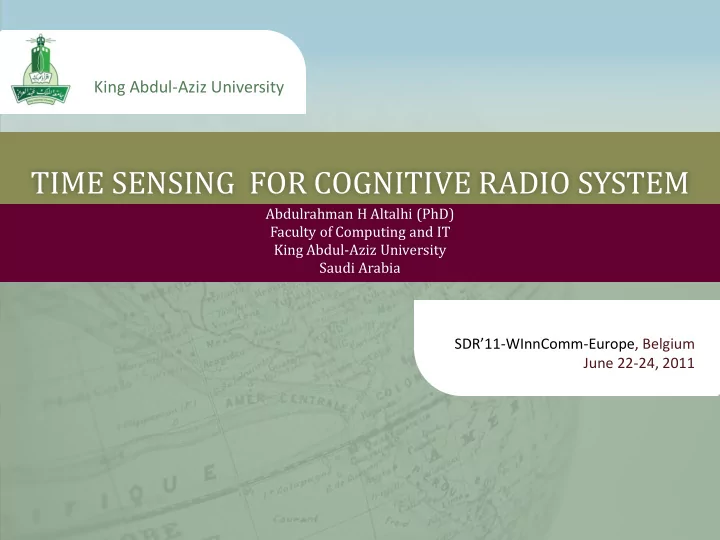

King Abdul-Aziz University TIME SENSING FOR COGNITIVE RADIO SYSTEM Abdulrahman H Altalhi (PhD) Faculty of Computing and IT King Abdul-Aziz University Saudi Arabia SDR’ 11-WInnComm-Europe, Belgium June 22-24, 2011
LAYOUT Introduction System Architecture Methodology and Analysis Simulation Model Results and discussion Conclusion Future Works
MOBILE NEXT GENERATION NETWORK Cognitive Femto cell technology is the Horizontal Handover underlying UMTS technology behind Ad Hoc Network Network the solutions proposed to LTE address capacity Horizontal Network UMTS Handover Network and performance WLAN improvement in WLAN Vertical Vertical Handover MNGN Handover MNGN is a heterogeneous network in which different access technologies are arranged in different topologies.
SENSING (FREQUENCY) IN COGNITIVE RADIO Sensing the spectrum is the most important function in cognitive radio system. It is important to determine utilized/unutilized frequency within the spectrum. Sensing accuracy and system simplicity are inversely related Methods for sensing (frequency): – Energy detection – Matched Filter – Cyclostationary detection
SENSING (TIME) • Sensing duration (i.e. how long should cognitive radio switch to sensing mode) is a challenging aspect in spectrum sensing as primary users can claim their frequency at any time. • Thus Sensing frequency (i.e. how often cognitive radio should perform spectrum sensing) brings about a tradeoff between time of sensing and accuracy. • Characterizing the interference will help to resolve complexity
WIDEBAND CHIRP SIGNAL (RESOLUTIONS) Chirp signal is wideband signal generated by linearly sweep (increase/decrease) the instantaneous frequency of sine wave. Spectrum resolution is obtained by correlating the chirp with itself Time resolution is obtained by correlating the chirp with its conjugate
SYSTEM ARCHITECTURE Communication signal between primary user and primary base primary base station station Reference chirp signal Cognitive radio user Primary coverage area Cognitive radio Cognitive radio Primary users coverage area base station
SENSING FREQUENCY AWGN Chirp Chirp Decision FFT + (Ref) MF Circuit CR receiver Primary Primary user Primary user user
RESULTS (EFFECT OF AWGN) peak d SINR = 10 dB SINR = -5 dB
SENSING TIME AWGN Time Chirp Cross + correlation Estimation (Ref) Chirp Time (Conjugate) Primary Delay user CR receiver
RESULTS (CHIRP TIME RESOLUTION) delay
RESULTS (SINR VERSUS P e ) Noncoherent detection Pe Coherent detection SINR
RESULTS (RECEIVING 2 TONES)
CONCLUSIONS & FUTURE WORK Sensing cognitive radio environment using chirp signal is tested Time resolution of chirp signal is used to determine user temporal behaviour As SIR decreases Pe of delay estimation increases Coherent detection of the carrier improves Pe In future work we will look into network level simulation to study the limitations of the suggested strategy. We will also work on testbed implementation.
FUTURE WORK Noise Frequency CDMA Interference characterizer Sensing Control PSK, FSK + Unit FM, AM Time Sensing OFDMA
Q&A Thank you
Recommend
More recommend